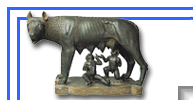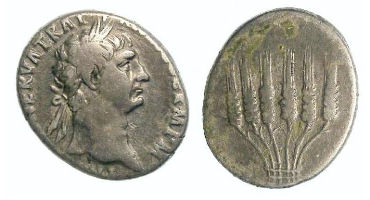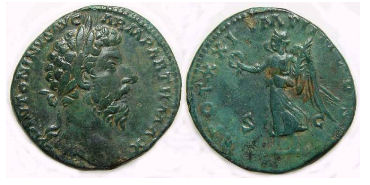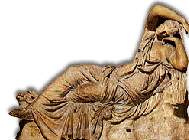 |
 |
ANCIENT ROMAN COINS - Imperial
|
|||||||||||||
|
(Reference: S=Sear Roman Coins and Their Values (2000 edtion), RSC=Roman Silver Coins, RIC=Roman Imperial Coinage, MILNE=Catalogue of Alexandrian coins; GIC=Greek Imperial Coinage by Seaby) |
|
 Trajan,
AD 98 to 117, Silver Cistophorus.
SOLD
|
 Marcus Aurelius, AD 161 to 180, Bronze
sestertius.
Denomination: Bronze sestertius. Mint: Rome. Date: issue of AD 167. Reference: RIC III #948, Banti #436. Size: 29.4 x 31.6 mm. Weight: 24.37 grams. Grade: gVF, with a very attractive sea green patination. Obverse: Head of Marcus Aurelius right, with M ANTONINVS AVG ARM PART II MAX around. Reverse: Victory walking left, holding a wreath and palm branch, with TR POT XXI IMP IIII COS VII around (some letters are weak), and S C in the fields. SOLD |
 Hadrian,
AD 117 to 137, Silver Cistophorus.
SOLD
|
 Faustina Senior. AD 139 to 141.
Denomination: Silver denarius.Life time issue silver denarius. Mint: Rome. Date: AD 139 Reference: Sear-4667 Size: 16.0 x 17.6 mm. Weight: 3.17 grams. Grade: VF Obverse: Head of Faustina Senior right, with FAVSTINA AVG ANTONINI AVG P P around. The portrait is much more "matronly" looking than one sees on the later issues, and is probably closer to what she really looked like. Reverse: Concordia seated left, holding a palladium and sceptre, with CONCORDIA AVG around. Coins of Faustina Sr. struck during here lifetime are much rarer than the later DIVA issues struck in commemoration of her. SOLD |
|
(Reference: S=Sear Roman Coins and Their Values (2000 edtion), RSC=Roman Silver Coins, RIC=Roman Imperial Coinage, MILNE=Catalogue of Alexandrian coins; GIC=Greek Imperial Coinage by Seaby) |
|
ALL PRICES ARE IN US DOLLARS
CANADIAN ORDERS MUST ADD GST/HST TO ALL PRICES
FOR ADDITIONAL ANCIENT COINS WE HAVE AVAILABLE
PLEASE SEE OUR VCOINS STORE
www.vcoins.com/calgarycoinNext page of Roman Coins
Top of Page


THE ADOPTIVE EMPERORSThis was probably the best time to have been a Roman. In a stroke of brilliance, Nerva, who had been proclaimed Emperor after the assassination of Domitian, realized that it was better to choose a worthy successor than to rely on genetics for good government. Since succession tended to be smoother when passed from father to son, Nerva adopted Trajan, who adopted Hadrian, who adopted Antoninus Pius, who adopted Marcus Aurelius and Lucius Verus (co-emperors), resulting in 84 years of what appears to have been good government and prosperous times for the Roman people. Unfortunately, Marcus Aurelius broke with tradition and passed the reins of power to his unworthy natural son Commodus. TRAJAN, AD 98-117As the first of the adopted emperors, Trajan is also remembered as one of the good emperors under whom the Empire prospered. He greatly expanded the frontiers with annexation of Dacia, Armenia and Mesopotamia, and is also remembered for expanding and rebuilding the networks of roads, bridges and aqueducts which were very necessary for the smooth operation and control of the Empire. Even the famous wall in Britain, commonly known as Hadrian's Wall, was probably a project initiated by Trajan. ANTONINUS PIUS, AD 138-161FAUSTINA SENIOR, Wife of Antoninus PiusFaustina Senior was married to Antoninus Pius before he came to the throne in AD 138 and unfortunately she died less than three years later in AD 141. Antoninus Pius must have held her in very high regard as he never re-married, and continued to strike coins in her honour, with her name and image, until the end of his reign. Coins issued for her prior to her death are quite scarce, but can be easily identified as they lack "DIVA" at the beginning of the obverse legends. MARCUS AURELIUS, AD 161-180Marcus Aurelius was born in AD 121 to a distinguished Spanish family then living in Rome. He was a favorite of Hadrian, who saw that he was properly educated and may have been grooming him for succession, but Marcus Aurelius was too young (15) when Hadrian had to see to the succession. Hadrian adopted Antoninus Pius, but obliged Antoninus to adopt Marcus. Marcus later married Faustina Jr, the daughter of Antoninus Pius, and by her fathered at least thirteen children, including the future emperor Commodus. He was devoted to the study of philosophy, hence he is sometimes referred to as the Philosopher King. LUCILLA, wife of Lucius VerusLucilla was born in AD 149, the daughter of Marcus Aurelius and Faustina Junior and sister to Commodus. She married Lucius Verus in AD 164 and had three children by him, although there is no record of what became of them. After the death of Verus, she was at first honored by Commodus, but was later implicated in a plot against him and was exiled to Capri where she was executed in AD 182. COMMODUS, AD 177-192Commodus is recorded as one of the bad-boys of Roman History. As the son of Marcus Aurelius, he became co-emperor in AD 177 and then sole Emperor upon Aurelius' death in AD 180. It appears that he neglected his duties as Emperor, leaving the administration of the Empire to others, and probably went insane, coming to believe he was the reincarnation of Hercules. |
| Top of Page Copyright © 1997-2005 R & T Enterprises Ltd. |
 |